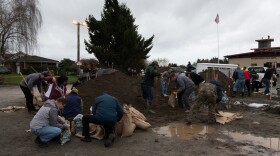How to protect marbled murrelet habitat in state-owned forests is in the spotlight this week in Washington, as the state’s Department of Natural Resources kicks off a series of public meetings on a range of strategies for a 50-year conservation plan of the endangered seabird.
Marbled murrelets nest in old-growth trees, some of which are in prime areas for logging. The state has for many years had in place an interim conservation plan, because scientists wanted extra time to study what the bird needs. It wasn’t till the 1970s that they established the murrelets’ unusual habit of nesting high up in the forest canopy as much as 50 miles from the coastal areas where they feed.
The beach at Mulkiteo State Park is one of just a few spots around Puget Sound where you might find marbled murrelets in winter. On a recent morning, a large sea lion could be seen diving offshore near the park’s lighthouse and there were lots of different seabirds flitting around in pairs. But there were no marbled murrelets in sight.
“This is an endangered species. They’ve lost so much of their habitat,” said Shawn Cantrell, the Northwest Director of Defenders of Wildlife, which is one of several groups working to keep the seabird from going extinct.
“Part of the reason that the state Department of Fish and Wildlife recently up-listed the murrelet from threatened to endangered status is because the population has continued to decline every year at an average of 4.4 percent,” he said.
Cantrell says the biggest driver of the bird’s decline is actually not on the waterfront, but in the forests, where the unique seabirds nest. So we head to a greenbelt up the road.
Cantrell stops in front of what looks like a 30-year-old cedar to illustrate what murrelets need. He says this tree is getting there, but it hasn’t yet grown enough of the wide mossy limbs high up in the forest canopy, where the birds lay their eggs.
“It needs another 20-30 years before it would have branches that could sustain murrelet nesting.”
And they would need to be more sheltered than this area, to keep them hidden from crows and other predators, Cantrell says, so keeping marbled murrelets from going extinct will take a long-term commitment to cultivating very old trees on state owned lands. And he says none of the Department of Natural Resources’ current strategy options will help save the bird. That’s why the coalition he’s part of is asking the new commissioner of public lands to take another look, especially at the habitat in Southwest Washington.
Forestry groups and staff at DNR say the state-owned lands are just a small piece of the puzzle. Matt Comisky, Washington state manager with the industry group the American Forest Research Council, says DNR only manages about 9 percent of the forestland where murrelets nest in Washington.
“A lot of this may be driven by at-sea conditions and food forage issues,” he said, adding that the state needs to balance its conservation goals with its mandate to generate revenue for schools and county services through logging.
“Stopping and backing up I don’t feel is in the best interest of the bird or the beneficiaries. Because we could delay this another 7 to 10 years and not change anything.”
But many groups still say now is the time to reconsider, before the state DNR board votes on a strategy that will affect its forests for the next 50 years.
“Those hundred-year-old trees are providing so many more services than just habitat. They’re providing carbon sequestration, clean water. And Washingtonians – time and time again – say that what they value are their trees and their clean water,” said Lisa Remlinger, forest program manager with the Washington Environmental Council.
“So while we’re talking about the bird and this is an opportunity to protect murrelets and give those birds a chance, it’s really an even bigger picture than that, that Washington citizens should be concerned about,” she said, adding that it could also be an opportunity to consider new revenue generation possibilities from the state owned forests, such as charging fees for the ecosystem services they provide.











